- Home
- /
CONSTIPATION RELIEF DURING TOILET TIME – THE COMPLETE GUIDE
- Medically reviewed by: Horia Marculescu, MD
- Photo credits: Licenses / Author
- Last updated: 14.03.2024
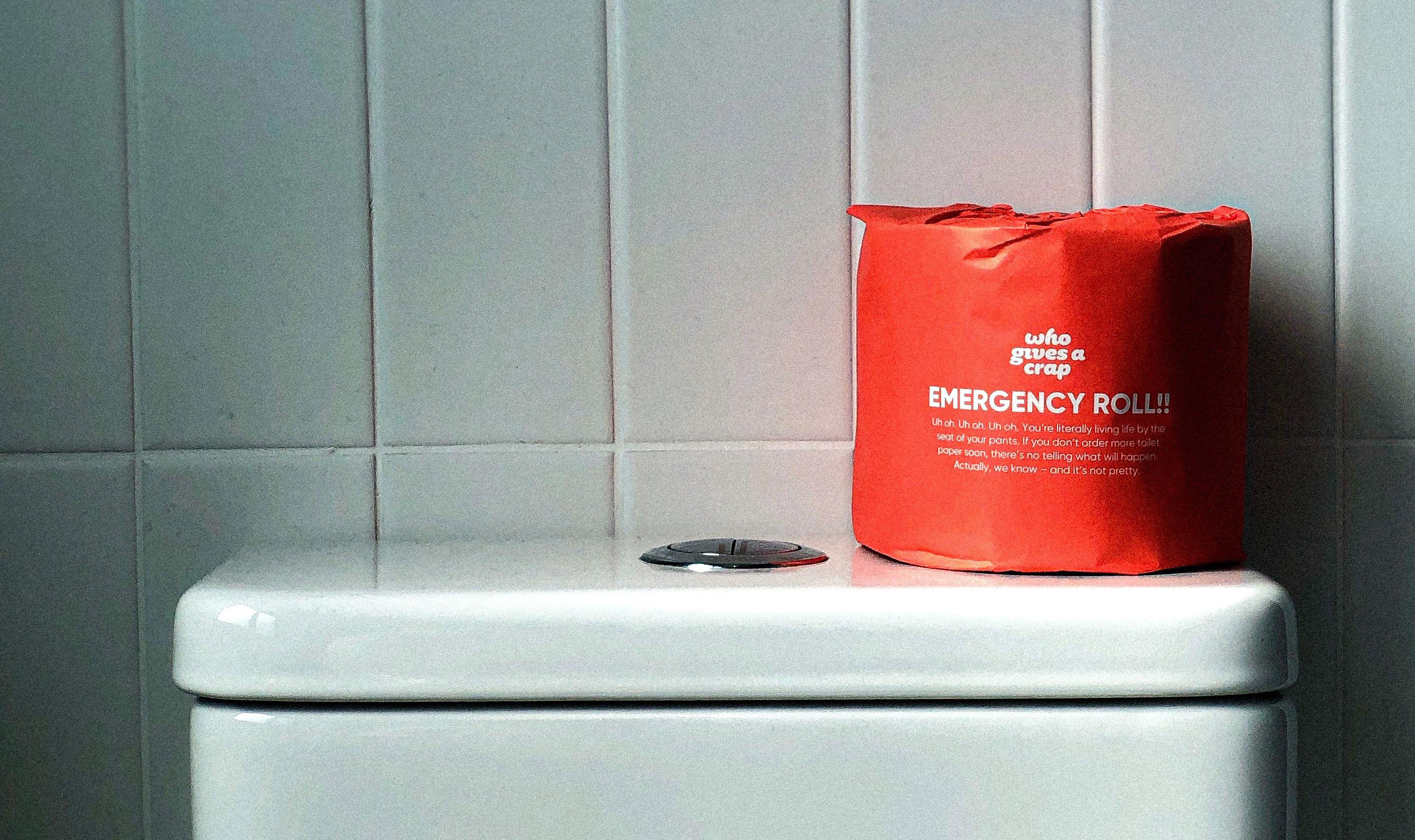
Achieving constipation relief during toilet time entails:
- Hydrating the body and intestines.
- Adopting a semi-squat posture on the toilet bowl.
- Increasing the anorectal angle.
- Relaxing the sphincter.
- Unlocking the kink at the entrance of the rectum.
- Generating pressure inside the intestines.
Follow this guide to explore eight straightforward solutions for smoother defecation and long-term improvement of intestinal transit.
1. ENSURING INTESTINAL HYDRATION FOR CONSTIPATION RELIEF
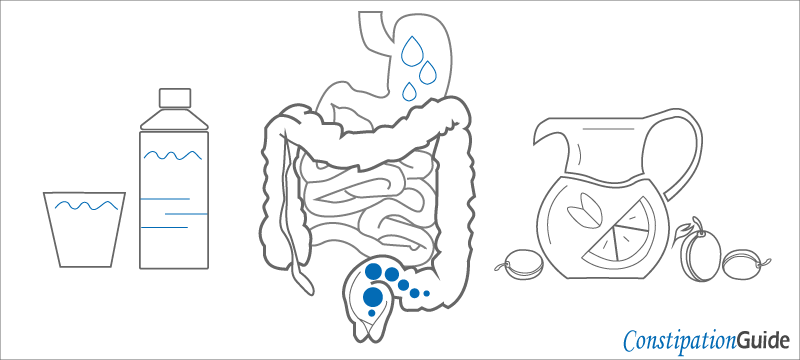
Optimal constipation relief during toilet time often begins with prioritizing hydration for your body and intestines.
Hydration plays a pivotal role in facilitating digestion and promoting efficient stool evacuation.
Maintaining adequate hydration levels is fundamental for preventing constipation in the long run.
Dehydration and its Impact on Bowel Movements
Dehydration can significantly affect bowel movements, particularly in individuals suffering from constipation, where stools become dry and adhere stubbornly to the intestinal walls.
This frequent accumulation of fecal matter in the large intestine exacerbates constipation, leading to difficulty in defecation.
Various factors contribute to dehydration, including:
- Stress;
- Obesity;
- Diabetes
- Physical exertion.
These factors can disrupt the body's fluid balance.
Proper nutrition plays a crucial role in maintaining healthy intestinal transit.
Consumption of difficult-to-digest foods such as bread, potatoes, pasta, sugary items, rice, cheese, eggs, and high-fat meats can contribute to constipation.
To eliminate these causes, you should improve your eating habits and hydrate your body.
“Dehydration means the body lacks enough fluid and electrolytes—chemicals in salts, including sodium, potassium, and chloride—to work properly.”
Eat fruits on an empty stomach for optimal benefits:
- Start your day with 2-3 apples upon waking up.
- Consume fruits at least 4 hours after your last meal.
- Enjoy a refreshing fruit salad for breakfast.
Wait for 30-60 minutes before consuming other foods. After a meal, wait 4-5 hours before eating fruits again.
Consuming fruits on an empty stomach is a great way to enhance digestion and promote hydration.
Hydration involves a complex chemical process that relies on essential vitamins and nutrients abundantly found in unpeeled fruits.
Consume fruits exclusively on an empty stomach. In this way, digestion will absorb all of the nutrients and vitamins.
Fruits digest quickly, whereas consuming them alongside other foods may lead to fermentation, which can diminish the nutritional content.
Drink Mineral Water
Maintaining hydration is crucial for constipation relief during toilet time.
Drinking non-carbonated mineral water plays an essential role in keeping your intestines hydrated.
How to Drink Water:
- Consume a glass of water 30 minutes after a meal.
- Drink another glass of water 2 hours after a meal.
- Avoid drinking water immediately before a meal.
It's important to note that water cannot directly reach the large intestine after passing through the end of the small intestine.
However, the stool in the large intestine can absorb water from elsewhere in the body.
Always opt for non-carbonated water, as carbon dioxide can stimulate the pancreas to release insulin, potentially disrupting digestion and the proper functioning of the small intestine.
Health experts from The U.S. Center for Disease Control and Prevention state that:
“Drinking water can prevent dehydration, a condition that can cause constipation.”
Enjoy Fresh Fruit Juice Responsibly
While fresh fruit juice offers similar benefits to consuming raw fruits, it's essential to be mindful of its consumption due to the rapid occurrence of fermentation.
Juice will oxidize due to heat, humidity, and fructose content.
This oxidation can impede the proper assimilation of all nutrients and vitamins.
For instance, consider having a glass of fresh fruit juice before exercising.
You can also have fresh fruit juice before work.
“The treatment for dehydration is to replace the lost fluids and electrolytes. For mild cases, you may need to drink lots of water.” (U.S. National Institue of Health)
2. INCREASE THE ANORECTAL ANGLE

The anorectal angle is an essential element when it comes to constipation relief during toilet time.
The anorectal angle makes the kink at the end of the anorectal canal to keep the rectum locked.
This action prevents leaks of the fecal matter.
This action is essential because it prevents leaks in our everyday movements like:
- Standing on our feet.
- Staying horizontally on the bed.
In normal circumstances, the kink at the beginning of the rectum stays locked to prevent leaks.
Whenever we need to go to the toilet, the kink unlocks itself using signals from the brain and body.
According to a medical study called "How to Interpret a Functional or Motility Test – Defecography":
“The anorectal angle (ARA) is measured between the longitudinal axis of the anal canal and the posterior rectal line, parallel to the longitudinal axis of the rectum.”
How to Increase the Anorectal Angle:
You can increase the anorectal angle by adopting the squat posture, which is the optimal way to sit on the toilet bowl.
Squatting not only increases the anorectal angle but also straightens the anorectal canal.
To squat, stand on your feet, lower your body, and keep your knees higher than your hips.
Try the squat position for 5-10 minutes before using the toilet.
If you frequently experience constipation, aim to squat 3-5 times daily.
Medical research from the Radiological Society of North America points out that:
“During straining and defecation, the anorectal angle becomes more obtuse for the relaxation of the puborectalis muscle.”
“The anal sphincters and puborectalis appeared normal in over 90% of women.”
“During dynamic MRI, the anorectal angle was 100 ± 1º at rest, 70 ± 2° at squeeze, and 120 ± 2° during defecation.”
3. USE ABDOMINAL MASSAGE
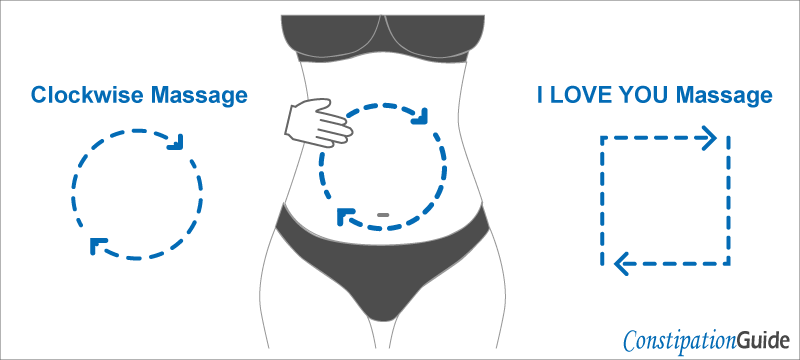
Abdominal massage is an excellent technique to stimulate bowel movement.
It is also an excellent technique to have constipation relief during toilet time.
If muscle contraction does not create enough pressure to make you go to the toilet, then an abdominal massage will help.
The abdominal massage focuses on the large intestine, which forms a circle over your abdomen.
Clockwise Abdominal Massage Technique:
To perform a beneficial abdominal massage:
- Begin by placing your palm gently on your abdomen, focusing on the area over the large intestine.
- Apply gentle pressure in a circular motion, moving your palm clockwise.
- Continue the circular motion, ensuring to cover the entire surface of the large intestine.
Repeat these steps 5-10 times with gentle and consistent pressure.
Health experts from The Continence Foundation of Australia state that:
“People who have a history of holding on to their bladder and bowels can also develop tension in their pelvic floor muscles.”
“For instance, some people feel uncomfortable using public toilets. So they may hold on to their bladders for hours until they come back home from school, work, or social activities.”
"I Love You" Abdominal Massage:
This massage technique closely resembles the one mentioned previously, with a few distinctions:
- Begin by placing your palm over the ascending colon.
- Continue by massaging the transverse colon.
- Conclude the massage by focusing on the descending colon.
Apply more pressure with your palm if you detect the presence of fecal matter.
Increase pressure if the fecal matter moves towards the rectum.
However, ensure to maintain a slow and gentle pushing motion.
Here is a straightforward example to follow during abdominal massage:
As you massage the abdomen, incorporate deep breathing exercises:
- Inhale deeply and slowly.
- Hold the breath for 5-10 seconds.
- Exhale slowly and steadily.
Repeat this breathing pattern for 5 minutes. Afterward, take a short break.
“The data from the study showed that abdominal massage decreased the severity of constipation, the feeling of incomplete bowel emptying, the severity of straining, and the severity of anal pain.”
4. SUPPLEMENTS AND LAXATIVES

Supplements and laxatives improve digestion and bowel movement with ease.
The effects of these remedies are typically rapid and generally lack short-term side effects.
However, long-term use of laxatives may lead to dependency.
It's important to note that supplements cannot consistently substitute for your body's natural chemical functions.
Using laxatives can be beneficial before seeking constipation relief during toilet time.
Always consult your doctor for their professional opinion on this matter.
Consider Using Mild Laxatives
Mild laxatives serve various purposes based on the type of constipation and accompanying symptoms.
Common types include:
- Emollient laxatives (stool softeners).
- Bulk-forming laxatives (increase stool volume).
- Stimulant laxatives (stimulate intestinal contractions).
- Osmotic laxatives (draw water into the colon).
- Laxatives for enema preparation.
Stimulant laxatives, readily available over the counter at pharmacies, work by stimulating intestinal contractions.
Osmotic laxatives aid bowel movements by drawing water into the colon.
Stool softeners help moisten dry and sticky stools by retaining water from other parts of the intestines.
Consult a healthcare professional before beginning any laxative regimen to determine the most appropriate type and dosage for your specific condition.
Health experts from The American Gastroenterological Association Institute state that:
“Laxatives are a broad category of agents that induce laxation in various ways.”
“While in the broadest sense, any agent that stimulates or facilitates the evacuation of the bowels can be considered a laxative.”
Health experts from The U.S. Food & Drug Administration recommend:
“Constipation is marked by infrequent bowel movements or difficulty in passing stools. Use Certain Laxatives with Caution.”
Consider Taking Pancreatic Enzyme Supplements
Pancreatic supplements offer essential enzymes crucial for proper digestion when the pancreas doesn't produce enough naturally.
Pancreatin, a vital enzyme mixture, contains lipase, amylase, and protease, which function as follows:
- Lipase breaks down fats.
- Amylase breaks down carbohydrates.
- Protease breaks down proteins, aiding optimal nutrient absorption.
Individuals with insufficient exocrine pancreatic function may find these tablets beneficial.
“Liver, pancreatic, ... diseases are often associated with nutritional difficulties and necessitate an adequate nutritional therapy in order to support the medical treatment.”
Take Hepatic Bile Stimulants
Bile plays a crucial role in fat absorption by emulsifying fats and activating pancreatic lipase.
Bile aids the absorption of essential vitamins such as A, D, E, and K.
Furthermore, bile promotes peristalsis, which enhances long-term bowel movement.
If your liver fails to produce sufficient bile secretion, consider taking a supplement periodically to ensure proper function.
5. USE NATURAL LAXATIVES
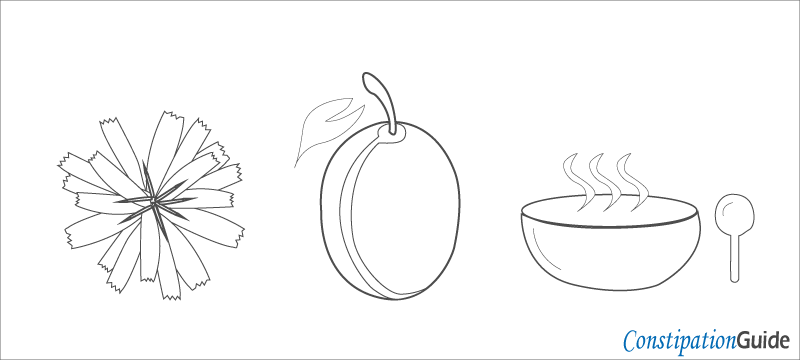
Using natural laxatives helps with constipation relief during toilet time.
These laxatives can take the form of leaves, fermenting fruits, or liquid foods.
Prior to visiting the toilet, consider the following:
- Consume warm vegetable soup.
- Enjoy a fruit salad.
- Drink a glass of chicory juice.
Each type of natural laxative works differently. Chicory, for instance, contains both cellulose and fructose in small quantities.
Fruits such as plums or prunes, abundant in fructose, promote fermentation and gas production.
Additionally, warm liquids ingested before visiting the toilet enhance intestinal motility by naturally increasing volume.
Chicory Is a Natural Laxative
Chicory is a natural laxative that is available in the form of leaves or powder.
Chicory has laxative effects because of inulin and cellulose.
You can mix chicory juice with fruit juice, which has an intense effect overall. Chicory powder is usually available as inulin powder.
You can take a glass of warm tea and mix it with a tablespoon of inulin. Do not mix more than one tablespoon too often.
“The most robust evidence exists for the use of inulin as a prebiotic, and in this context also, the prebiotic activity of chicory root has been investigated quite intensively.”
According to a medical study about the Fiber-Rich Cichorium intybus L. Taproots:
“Nowadays, chicory roots are mainly applied as a source for the extraction of inulin, which is used as a prebiotic fiber and food ingredient.”
“Chicory roots, however, have long been consumed as a vegetable by humans.”
Fast-Fermenting Fruits:
- Apples.
- Prunes.
- Grapes.
- Cherries.
- Oranges.
These fruits ferment rapidly, resulting in the production of gas within the intestines.
Fermentation occurs due to prolonged retention of fruit in the intestines, coupled with heat, fructose, and humidity.
This process resembles the production of alcohol on a smaller scale.
The gas generated helps propel stool movement and expands the intestines.
Combined with the indigestible fiber present in their composition, these five fruits exhibit laxative effects.
Liquid Food
Warm or hot vegetable soups have a unique ability to fill and expand the intestines.
As mentioned earlier, this increase in volume aids motility temporarily.
The increased liquid volume helps propel matter toward the rectum for evacuation.
Consuming a bowl of warm soup, particularly a vegetable cream soup, on an empty stomach effectively dissolves fats and promotes the movement of sticky stool toward the large intestine.
Consider making warm vegetable soup your first meal of the day, and anticipate using the restroom within approximately 30 minutes
6. USE THE IDEAL POSITION
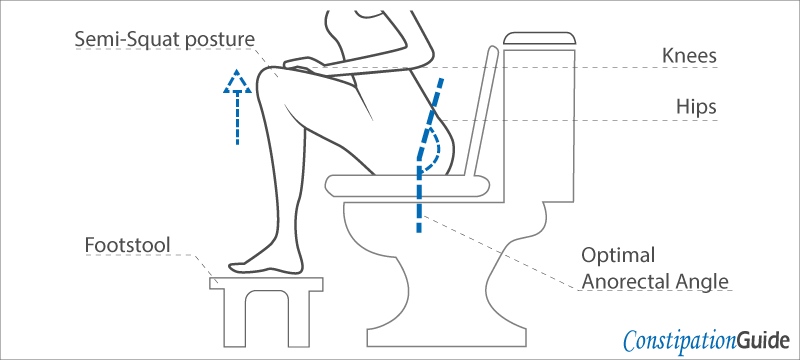
The squat posture is highly effective for constipation relief during toilet time.
The squat posture does the following actions:
- It relaxes the anal sphincter.
- It relaxes the puborectalis muscles.
- It unlocks the kink at the entrance of the rectum.
Modern standard toilet bowls resemble chairs, maintaining the knees at the same level as the hips. However, this position is not ideal as it keeps the kink at the entrance of the rectum locked.
Fortunately, there is a solution.
You can enhance your posture by placing a footstool under your feet while seated on the toilet bowl.
A low-rise footstool or squatty potty elevates your knees above your hips.
This thing facilitates an increase in the anorectal angle effortlessly.
According to a comparative study about straining during defecation in three positions (US NLM):
“The present study confirmed that the sensation of satisfactory bowel emptying in the sitting defecation posture necessitates excessive expulsive effort compared to the squatting posture.”
Health experts from Queensland Health – Australia state that:
“There’s an optimal body position to be in when doing your business if you’re taking a seat.”
“Sit with your knees higher than your hips (use a footstool or other flat, stable object if necessary).”
Raise Your Arms
As you sit on the toilet preparing to defecate, gradually lift your arms and maintain this position for 10 seconds.
Then, slowly close your palms to engage your abdomen and create pressure.
Take a brief pause and repeat the process.
Here's a practical example: While working at your computer, you can use support or footstool to elevate your knees.
Health experts from The Continence Foundation of Australia note that:
“Correct toilet position. Knees higher than hips. Lean forward and put elbows on your knees. Bulge out your abdomen. Straighten your spine.”
Medical research about defecation and body position in humans note that:
“The greater the hip flexion achieved by squatting, the straighter the rectoanal canal will be, and accordingly, less strain will be required for defecation.”
7. SIMULATE DEFECATION
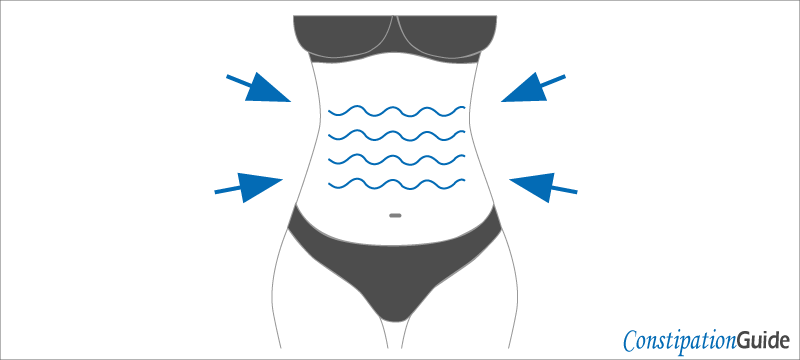
Constipation relief during toilet time involves preparation, simulation, and stool evacuation.
Simulating the strain and muscle contractions of defecation is an excellent preparation technique.
When you feel the need to use the toilet, you can gently apply pressure inside the intestines.
The more pressure you exert, the more likely the stool will move.
How to Simulate Defecation
To simulate defecation effectively, follow these steps:
- Take a deep breath.
- Hold the air inside for 5-10 seconds.
- Release the air.
Repeat this process ten times and then take a break.
Filling your lungs with air will expand the abdomen. This action will create intestinal pressure.
Fecal matter containing fructose, glucose, flour, and carbohydrates ferments and decomposes.
Fermentation produces gas, which pushes nearby stool toward the rectum.
Additionally, incorporating light exercises such as crunches, push-ups, or jogging into your morning or daily routine can stimulate your internals for bowel movements.
Utilize Abdominal Contraction
Simultaneously, engage in abdominal contraction or tighten your abdominal muscles.
However, avoid focusing on the rectum at this moment.
Contract your abdomen as if you were having a bowel movement, but without involving the anus.
Here are a few essential steps outlining what to do on the toilet bowl.
Here is an example. The presence of gas or air inside the large intestine indicates that fecal matter is ready to evacuate.
According to a study called “Biofeedback Therapy For Constipation In Adults”:
“Several randomized controlled trails have demonstrated that biofeedback therapy using neuromuscular training and visual and verbal feedback is not only efficacious, but superior to other modalities such as laxative.”
8. GENTLY PUSH THE RECTUM
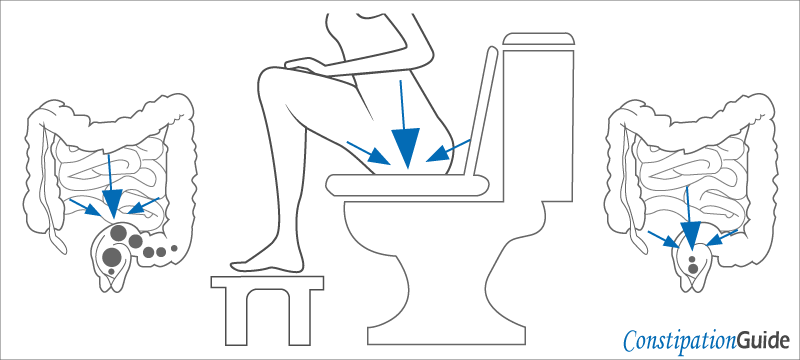
Sit on the toilet bowl and apply pressure to facilitate bowel movement.
If you feel gas coming out with ease and the large intestine is filled, you are ready to defecate.
Constipation relief during toilet time becomes easier with practice.
The more you practice, the better you become at managing constipation.
When you feel the stool filling the rectum, take a seat on the toilet bowl and do the following:
- Gently push the abdomen.
- Allow pressure to aid in stool expulsion.
- Squeeze and push the rectum.
Push harder when you feel the fecal matter inside the rectum (or anus).
Push only as much as the sensation is soft and gentle.
Avoid pushing too forcefully, even if you frequently experience constipation.
The stool should naturally pass with the assistance of pressure.
Apply more pressure if you feel the presence of fecal matter.
However, if the stool adheres to the intestinal walls like glue, avoid straining the rectum excessively.
If you experience bloating along with significant gas release, it's crucial to head to the toilet.
This occurrence is a positive indication that the stool isn't dry.
Research about Colonic Motility Dysfunction (Morgan & Claypool Life Sciences) points out that:
“Hard straining may not be enough to push feces against the closed internal and external anal sphincters.”
“Additional structural impairments in the pelvic floor function may exacerbate the difficulty in stool expulsion in some patients.”
Gastroenterologists from the American College of Gastroenterology state that:
“The introduction of DPMDs has resulted in increased awareness of anatomical differences based on an anorectal angle when squatting versus sitting. ”
“Participants have reduced time, reduced straining, and increased bowel emptiness.”
KEEP IN MIND
Avoid excessive straining and pushing of the rectum to prevent the development of hemorrhoids.
The anal sphincter and surrounding tissues have limited capacity to withstand pressure.
If you experience severe symptoms of constipation, seek medical evaluation from a doctor.
Taking stool, urine, and blood tests would be beneficial for diagnosis.
There are numerous techniques for achieving constipation relief during toilet time.
However, the fundamental ones outlined in this guide align with the anatomical functioning of our bodies.
Hydrating the intestines and practicing to increase the anorectal angle are essential steps.
Adopting a squat posture helps prepare your body as well.
Lastly, positioning yourself correctly on the toilet bowl and gently straining the rectum contributes to a natural and smooth bowel movement experience.
Last medically reviewed on 14.03.2024